After the resource is depleted with bituminous mastics or roofing material, waterproofing of the old foundation of the house becomes relevant to increase the resource of power structures. In this case, it is necessary to protect the side surfaces of the foundation from soil moisture, groundwater and wastewater, lay drains around the perimeter, and make horizontal cut-off waterproofing between the foundation and walls. If you are interested in horizontal cut-off waterproofing, then if it is vertical, then read on.
If at the construction stage they forgot about waterproofing the foundation of the house or did it incorrectly, or the old protective coating has exhausted its resource, it is necessary to carry out a set of measures again to solve the following tasks:
- cutting off the walls from the basement of the foundation - the structural materials of the dwelling box draw in moisture from reinforced concrete structures and are destroyed much faster;
- protection of reinforcement from corrosion, concrete from destruction, increasing in volume by water, during freezing inside the structure of the material.
For example, if a cottage is built without a horizontal waterproofing carpet, the lower rims of the frame rot, and the brickwork collapses. In the absence of waterproofing of the outer edges of the foundation, the annual opening of cracks in concrete increases by 0.2 - 0.5 mm.
Attention! If in a dwelling with a basement, then the problem can be solved from the inside, but for MZLF you will have to expose the tape from the outside to provide access to concrete surfaces.
Vertical outdoor waterproofing
The main difficulty in repairing waterproofing is inaccessibility concrete surfaces... In addition, it is necessary to protect the foundation from the outside. Therefore, it is necessary to destroy the blind area, dismantle the facade and basement cladding.
After exposing the tape, waterproofing the foundation can be made using several technologies: plaster, paste over or coat with appropriate materials to protect the house from destruction.
Lubricants
Do-it-yourself waterproofing of the foundation by coating with epoxy, polymer or allows you to get a continuous film layer:
- the film is removed from the surface - chemical milling by successive application of a cleaner, activator, sandblasting, cleaning with a metal brush;
- the seams are deepened - grooves 2.5 x 2.5 cm at least to lay a bentonite rope in them;
- surface treatment - 2 - 3 layers of mastic on top of the primer, which serves to increase the surface roughness.
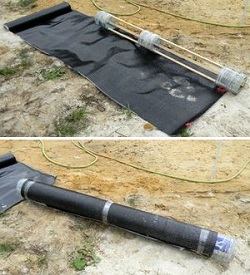
After that, the house will receive protection against wetting of the foundation and walls. The disadvantage is the low mechanical strength of the film, the integrity of which can be violated even by stones present in the backfill materials. Therefore, mastics often serve as the bottom layer of complex waterproofing. Before final drying, membranes, polyethylene films are glued to them, or rolled materials are fused.
Gluing materials
You can do the waterproofing of the foundation of the house with your own hands - with films, membranes. In the absence of plantar insulation, the rolls are launched to the bottom of the trench (10 - 20 cm), fused from the bottom up. Films are fixed to the surface with a special polymer glue, membranes and hydroglass insulation can have a self-adhesive layer.
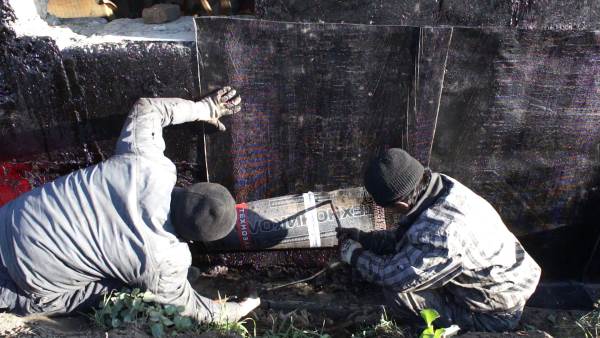
Waterproofing with roll materials.
If the level groundwater (GWL) is high or there is a possibility of its seasonal rise, three layers of material are required. With a low groundwater table, two layers of waterproofing carpet are sufficient. The main nuances of the technology are:
- longitudinal seam of adjacent sheets - at least 10 cm overlap;
- transverse seam - relevant when building rolls for buried strip foundations, is 20 - 30 cm, the upper roll covers the lower one in order to avoid leaks by analogy with laying roofing materials;
- arrangement of sheets - only vertically.
To increase the strength between the layers of pasting and coating insulation, a thin reinforcing mesh (polymer, galvanized, usually used for plaster coatings).
Attention! If rolled waterproofing is applied independently, the seams are treated with mastic. When performing complex protection, the mastic layer is under the hydroglass insulation by default, the seams can not be processed additionally.
The disadvantage is still the insufficient mechanical strength of the coating. The problem is completely solved by classical or wrinkle-sliding thermal insulation. In the first case, the surface is pasted over with EPPS high density polystyrene foam. An additional horizontal layer of EPS is laid under the blind area at a level of - 30 - 40 cm from the ground. This makes it possible to compensate for swelling completely, keeping geothermal heat in the soil layers adjacent to the foundation. In the second option, the EPS surface is additionally covered with polyethylene (attached only at the top to the wall). After that, the sheets of soft insulation PSB-S (polystyrene) are pressed against the polyethylene with the backfilling material of the trench without fixing to the wall. When swelling, the outer layer crumples. Shifts up the slippery film, returns to its original position in the spring.
Waterproof plasters
Do-it-yourself foundation waterproofing can be made in the form of a plaster layer. A cement-sand mortar is not suitable for these purposes, special dry mixtures with polymer additives are used to clog the pores of concrete in the upper layer:
- a plaster mesh is mounted on the surface;
- the surface is wetted, then the first layer of 0.5 - 1 cm is applied;
- after drying, finishing plastering is carried out to a total layer thickness of 2 - 3 cm.
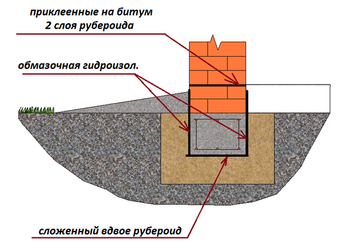
Waterproofing the foundation with special plaster mixes.
This is a budget solution for country house in comparison with coating and pasting technologies.
Attention: If there is heavy rainfall in the region of operation, in the area with a high GWL, buildings are required without fail. Drains are placed at the level of the foot of the foundation and drain water into an underground tank by gravity.
Internal waterproofing
If there is an exploited basement floor in the building, waterproofing of the foundation of the house from the inside is often used. Films, rolls and membrane materials are practically useless here:
- after the concrete gets wet, they peel off from the structural material;
- mechanical fixation is impossible;
- the effectiveness of protection is extremely low.
Injection waterproofing
From the inside, injection waterproofing of the foundation is often used, which can be done by hand only with sufficient work practice. The difficulty lies in determining the locations of drilling through holes in the supporting structure, which weaken its strength. The technology looks like:
- preparation - surfaces are examined for cracks and leaks;
- sealing gaps - with compounds, for example Penepurform or any other analogs;
- pits - holes along the diameter of the injectors according to the scheme at an angle of 45 degrees;
- injections - packers are inserted into the boreholes to inject repair mixtures.

Injection waterproofing of the foundation from the inside.
The components are mixed before injection, the operations are performed after the concrete has heated up to 35 degrees. The disadvantage is the lack of the necessary equipment in the arsenal of the home craftsman. Even renting it is more expensive than external waterproofing after digging trenches.
Volumetric waterproofing
The manufacturer Penetron and many others produce repair mixes for any operating conditions. All work can be done by hand to make all reinforced concrete structures of the house absolutely waterproof. The principle of operation of volumetric waterproofing is as follows:
- sealing of input nodes engineering systems, abutments, mates, joints, seams with Penekrit material;
- elimination of leaks (pressurized groundwater) with mixtures of Waterplag, Peneplag;
- laying of Penerab gaskets in the seams of FBS blocks or processing them with PeneProxy glue, Peneband tape;
- surface treatment with Penetron product.
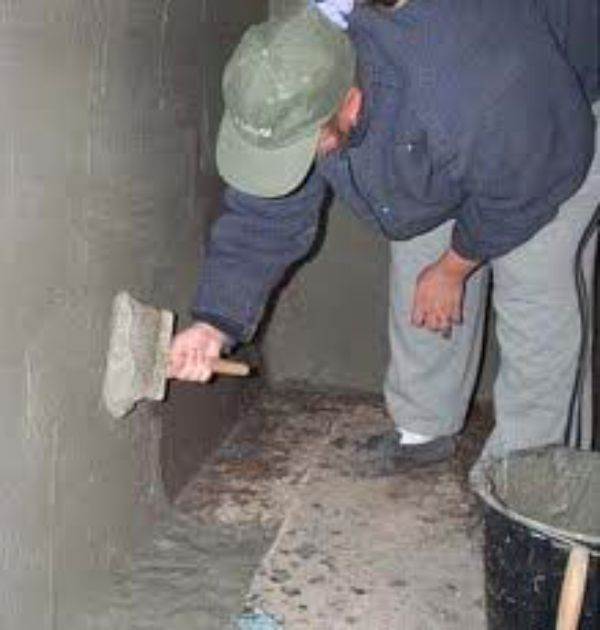
With the chemical interaction of the components of the mixture with the cement stone, a reverse osmosis reaction occurs. The molecular composition of concrete changes, after which the structural material receives new properties (water resistance) throughout the entire thickness of the structure.
If you saturate the bottom rows with Penetron brickworkhaving previously processed the seams with Peneproxy glue, they will completely replace the horizontal waterproofing of the walls. Moreover, over time, materials only gain strength, and do not lose it from contact with water. Therefore, the resource becomes unlimited - a chipped piece of concrete will completely retain its water resistance until it is completely destroyed by mechanical means.
The same manufacturer has products for injection (Penesplitsil based on epoxy, bituminous resins), plastering of defective surfaces (Screpa, which gives concrete, stone, brickwork structural strength).
Moreover, the company's specialists have developed the most demanded standard solutions:
- foundation tape from FBS blocks - Penekrit in the seams, Penetron over the entire surface of the concrete;
- brick wall from the inside - two layers of Penetron over the plaster reinforced with mesh;
- outside masonry - 2 layers of Penetron on cement-sand plaster;
- pressure leak - Peneplag + Penekrit (as a plug 2.5 x 2.5 cm);
- input of engineering systems - expansion of the groove up to 2.5 cm to a depth of 4 - 6 cm, layer; Peneplag / Waterplag, Penebar gasket, Penetron putty;
- floor / wall junction - strobe 2.5 x 2.5 cm at 45 degrees to the vertical filled with Penecrite.
Attention! Volumetric waterproofing with penetrating compounds (Penetron is not the only manufacturer of such compounds) reduces repair labor costs by an order of magnitude. Insulation of external surfaces from the inside of the basement - optimal solutioneliminating excavation work.
Horizontal shut-off waterproofing
In the structure of the old cottage, the wall rests on the foundation, which significantly complicates the installation of roofing material or hydroglass insulation with your own hands. To waterproof the foundation of a house, you will have to perform a complex of repair work:
- exposing the foundation - a trench close to the reinforced concrete structure with a depth to its bottom;
- unloading is usually partial, longitudinal or transverse beams are started;
- division of the perimeter - every meter the tape is divided by grippers;
- removal of wall material - cutting out an angle grinder with a disc on a brickwork stone or a crown of a log house with a chainsaw;
- screed - M100 mortar (preferably with a penetrating additive);
- waterproofing - two layers of roll material, the ends are bent to create an overlap in the adjacent area;
- wedging - replacement lower crown or a row of brickwork, filling the gaps with wedges, dry mortar (M100 and higher).
The option of horizontal waterproofing with penetrating compounds is also possible, read. But the most popular is injection horizontal waterproofing, it is done in the same way, only holes are drilled in the plane between the base and the masonry, the mixture is fed into these holes. Thus, a layer impregnated with waterproofing is created.
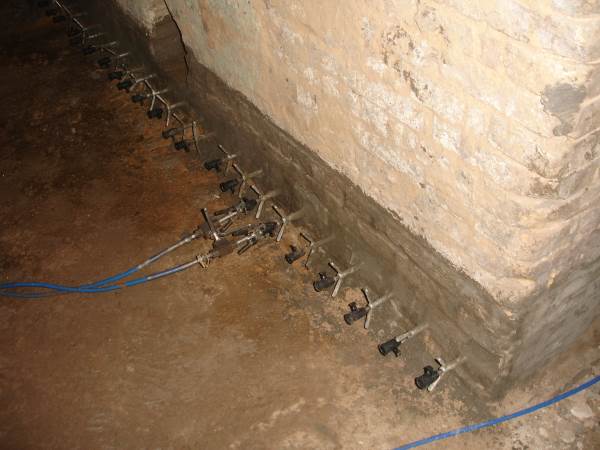
If the old built dwelling has whole crowns and lower rows of masonry, the building is simply lifted with jacks in compliance with the technical conditions:
- vertical movement of the long sides no more than 5 cm at a time;
- preliminary strapping of walls of log cabins with vertical boards (two self-tapping screws in each crown)
Attention: Work on adjacent grabs is carried out after hardening with the mortar used in the screed.
Thus, in an operating building, waterproofing of the foundation can be done in several ways, depending on the availability of an operating basement, UGV. All techniques are suitable for repairing a waterproof insulation layer on concrete structures homes designed to work in corrosive underground environments.
Advice! If you need contractors, there is a very convenient service for their selection. Just send in the form below a detailed description of the work that needs to be performed and you will receive offers with prices from construction teams and firms by mail. You can see reviews of each of them and photos with examples of work. It is FREE and non-binding.
"The water wears away the stone" - this statement is true not only in the allegorical sense that is put into it, but also in a completely direct way. Water can destroy a lot. Including concrete (read about its waterproofing here -). Therefore, in rooms with high humidity (or where there is a threat of increased humidity), it is necessary to waterproof the floor.
There are SNP requirements for floor waterproofing; of course if you build a private house for yourself, no one will force you to follow these requirements, however, these requirements are indeed due to necessity, and non-compliance will first lead to an uncomfortable existence in the house, and later - to its destruction.
There are several ways of waterproofing. In this article, we will take a closer look at them.
Floor paint waterproofing

Floor painting for insulation
This is the simplest variety, you do not need to have any skills to complete it, just patience is enough: varnishes (polymer or bituminous) are simply applied to the insulated surface in several layers.
This method is used most often for waterproofing a wooden floor.
This type of insulating coating is not very durable - its elasticity decreases over time, especially with serious temperature changes, as, for example, in a bath (it is heated irregularly, the temperature in winter even inside the room is quite low, then it rises sharply, then drops sharply again) ... The insulating layer begins to crack, after about 4-6 years it will have to be restored.
Plaster insulation
It is carried out with a solution of a base and a polymer or binder filler; the basis for which is most often cement.
The base also needs to be cleaned and dried; the cracks are sealed with a special putty, then the solution is applied in several layers. The mixture is sold dry, it is diluted with water as indicated in the instructions. The interval between application of layers is from 5 to 10 minutes.
Plaster insulation works are performed at temperatures above + 5 ° C, but below + 30 ° C.
Backfill waterproofing

A man makes a backfill to isolate the floor from water
It is also a fairly effective method, besides, it can be easily performed by anyone.
The method consists in the use of special bulk materials that become gelatinous; the resulting gelatinous mass practically does not pass water. Such waterproofing is also thermal insulation.
Preparation for such waterproofing is standard: the surface must be cleaned and dried. Before falling asleep, formwork is installed.
Cast version
This is the most reliable method today. And, accordingly, the most expensive. Materials such as bitumen, asphalt concrete, pitch are used.
Preparation of the base consists, as usual, in its cleaning, filling of cracks. Then the base is primed with hot bitumen, then the formwork is built, and then the entire surface of the floor is filled with heated material.
If you want to make several layers, please, but after applying the first layer and leveling it (done with a special metal scraper), you need to wait until it is completely hardened, and only then apply the second layer.
Okay way
As its name suggests, pasting insulation involves gluing the floor with special roll materials. It can be polymer or bitumen (or mixed polymer-bitumen) materials, consisting of components with increased resistance to decay.
Roll waterproofing for the floor is easy to use and can last for a long time (on average - 15 years), besides, some of its varieties can be installed at sub-zero temperatures, the quality of insulation does not suffer from this.
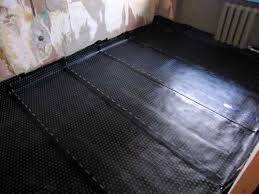
It looks like a pasting insulation
One of the modern insulating roll materials is hydroisol (gidrotekloizol). Rather, it is not even a material, but a whole group of materials, since they are produced on a different basis (fiberglass, fiberglass or polyester), with different types of top and bottom coatings (this can be fine-grained or coarse-grained dressing or polymer film).
Recently it is also gaining more and more popularity liquid waterproofing for the floor - which is a mastic based on polymer-bitumen emulsion. It is applied by spraying, has high adhesion to any surface, is resistant to temperatures and ultraviolet rays. Perhaps its only drawback today is the price. The elasticity of such a coating does not decrease over time; the service life can be 20 years or even more.
More details about the pasting method.
We considered different types waterproofing. And now let's talk about what types of waterproofing are used in a particular case and what are the features of the insulation of premises, depending on their purpose, as well as depending on the type of floor covering.
We do waterproofing of a concrete floor
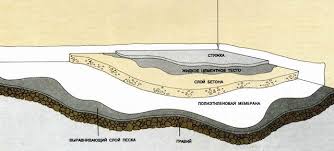
Concrete floor layout
Concrete itself practically does not allow water to pass through. However, there are “weak points” - the joints between the floor and the walls. For waterproofing a concrete floor, the coating and pasting options, which we discussed a little higher, are well suited.
It is imperative that you first clean the base well, then prime it thoroughly. After the primer has dried, cracks are closed (it is advisable to do this not only on the floor, but also on the walls).
If you are going to perform coating insulation (), this is enough, but if it is glued, you will have to level the floor first.
Wood floor processing
Wooden floors need moisture insulation much more than concrete floors.
Correct insulation of the wooden floor, if the house does not have a basement, must be done even during the construction of the foundation. If there is a basement, then it is imperative to correctly calculate and perform its ventilation.
From the basement side, it is necessary to insulate with isoplast or roofing felt.
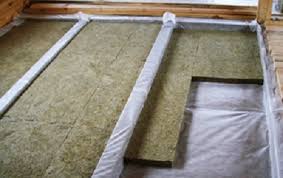
Insulation with cotton wool is also allowed
As for the waterproofing itself, the wood must be treated with special agents that increase its water-repellent properties, as well as anti-mold agents.
For wooden floors, cast, glued or paint insulation is more often used.
Whichever variety waterproofing materials you have not used, the wooden floor must be properly degreased and dried before insulation.
Features of bathroom waterproofing
If in other places it is simply desirable, then waterproofing the bathroom floor is a necessity. Unless, of course, you are not a fan of regularly doing repairs to your lower neighbors.
In addition to "flooding neighbors", high humidity also spoils interfloor overlap... Do-it-yourself waterproofing of the floor is quite simple.
If you are going to waterproof only the floor, then it is better to use the coating method. If funds allow you, it is better to give preference to German insulating mixtures.

Useful scheme for decorating a bathroom
You can also combine the coating and pasting methods.
We make the floor waterproofing under the screed
If you are just going to make a concrete screed and have not even thought about which one flooring will be used, it should be remembered that the insulation must be done before the screed is made.
In houses that do not have a basement, gravel sand pillowover which the film is laid. A layer of sand is poured on top of a well-packed layer of gravel (crushed stone) - such a pillow will protect against the rise of moisture from the soil through the capillaries, the film protects against water vapor.
It is possible (especially in the case of a basement) to perform waterproofing with mastic. You also need to treat the concrete with special waterproofing solutions (impregnating waterproofing).
How to waterproof the floor, which method and materials to choose is up to you. Just remember that trying to save money on waterproofing can result in much higher renovation and tidying costs.
Thanks. And a good day!
29 Aug 2016
Floor waterproofing is necessary not only in a private house. There are times when you can't do without it in apartments. If the apartment is on the ground floor above the basement, moisture and mold from the underground space can rise up the walls.
In this case, the floor will be constantly damp and cold, and over time it may even begin to crack and collapse. To avoid these troubles and the constant smell of mold in your apartment, waterproofing the floor is mandatory for the first floors. But there are times, especially in old houses, when even on upper floors the floor and walls are saturated with moisture that penetrates through cracks from the street. In this case, you also need to take care of reliable waterproofingto avoid the appearance of mold in the apartment, which is very dangerous to health.
As for private houses, waterproofing the floor in them is mandatory, even if it happened in accordance with all the rules and in compliance with all technologies.
Types of floor waterproofing
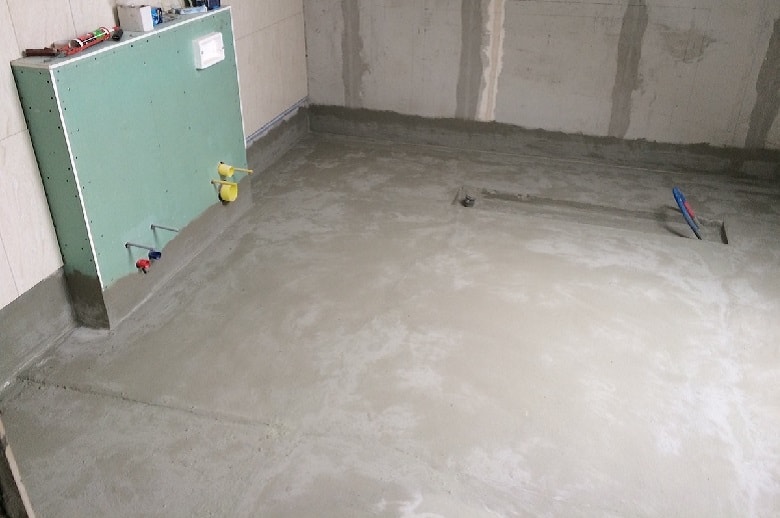
Materials for creating reliable waterproofing are selected taking into account what kind of room it is, how it will be used. In any case, these measures are aimed at creating a dense and reliable waterproof layer on the floor, which also has water-repellent properties. Thanks to this, the floor will be reliably protected from decay and destruction.
Waterproofing according to the field of application is:
- outward
- internal
Depending on the main water-repellent substance, it is divided into:
- bituminous
- polymer
- bitumen-polymer
- based on mineral components
Waterproofing the floor in the house can be done using the following materials:
- film
- roll
- membrane
- penetrating
- lining
- painting
- powder
- plastering
- coating
Film waterproofing materials

The most popular and familiar to everyone are roofing material, roofing felt and glass roofing material. In the last century, almost everything waterproofing works were carried out with the help of these building materials. They continue to be used in modern times, using not only floors, but also roofs and foundations for reliable moisture protection. These materials are dense cardboard or fiberglass, which are impregnated during their manufacture with bitumen and basalt chips. The result is a well-known roofing material or roofing felt.
DIY waterproofing with the help of such materials it is quite possible, because no special equipment is needed for their laying. It is very important to ensure that there is no large distance between the joints of the roofing material. Ideally, they should be soldered with a torch.
There are modern film materials that are used for waterproofing. These are multilayer polymer membranes that have, among other things, excellent thermal insulation properties. If waterproofing of a concrete floor is required, polypropylene, polyethylene or polyvinyl chloride films are most often used, all of them are available in rolls. They are laid before starting work on the creation of a cement-sand or dry screed.
Waterproofing mastic

If you are looking for a way to make waterproofing inexpensive and quickly, this building material is right for you. Mastic is a plastic adhesive compositionbased on liquid rubber, bitumen, resins, plasticizers and polymers. It is often used in residential areas to create a dense waterproof layer on the floor. It is also suitable for the treatment of joints in bathrooms, kitchens, swimming pools, saunas.
When choosing a mastic, pay attention that they are hot and cold. This material is good because, in addition to forming an elastic and dense waterproof film, it fills all cracks and pores in the material from which the floor is made.
Waterproofing materials liquid water-repellent

These include all kinds of paints, primers, varnishes, impregnations, injection compositions for local use, which, after hardening, create a dense water-repellent film. If breathable waterproofing of the floor screed is required, there are modern impregnations that penetrate deep into the pores of the material. After drying, they form air-permeable crystals that are completely impervious to water.
If you need waterproofing of a wooden floor, it is necessary to select liquid materials that are specifically designed for wood. As a rule, they protect not only from moisture, but also from the development of fungal microorganisms, as well as bark beetles.
Powder waterproofing materials

These are all kinds of dry mixes based on cement, glue, plasticizers and binders. With their help, dIY waterproofing, it is only important to carefully read the instructions and follow the application technology. To prepare such a mixture, you need to add water to it immediately before starting work. It is only important to observe the indicated proportions, if you are trying to save money and pour more water to get more mixture, the result may disappoint you.Such waterproof mixtures are suitable for creating concrete screeds not only in residential premises, but also in basements and bathrooms.
How to make waterproofing correctly
Whichever material you choose for waterproofing, there is for everyone general rule... At all places where the floor meets the walls, as well as with other protruding structures, for example, columns, the waterproofing layer must necessarily rise 30 cm above the floor level without interruption.
How to properly apply liquid waterproofing

The application technology depends on which material you have chosen, namely, impregnating or cast. Floor screed waterproofing with the help of cast materials, it can well be done independently. An even layer of bituminous or polymer solution is applied to the surface, which, after hardening, will turn into an elastic and dense waterproof film. Bituminous mastic must be preheated to + 120-140 degrees. Then it is poured onto a floor thoroughly cleaned of debris and dust. Using a spatula, it must be well leveled so that the layer is uniform.
Cast waterproofing under the floor is used in cases where it is necessary to protect a monolithic base from moisture before sanding is laid on it. cement screed... For reliability, several layers of waterproofing material will be required, if necessary, they can be reinforced with fiberglass or metal mesh. The thickness of the resulting waterproof film should be from 5 to 15 cm. Liquid waterproofing materials can be applied with a brush, but it is very convenient to do this using a spray.
Impregnating floor waterproofing consists in applying special impregnations to the floor surface. It is best to use a spray in this case to evenly distribute the waterproofing material over the entire floor. But you can also do this with a brush. Depending on the material from which the floor is made, an impregnation with the desired penetration depth is selected. After it hardens, a seamless monolithic waterproof membrane is obtained. This modern way waterproofing is very popular now, so it is provided in many already.
Creation of waterproofing using coating and coloring materials
The cast method of waterproofing involves working with heated materials, for example, mastic. The painting or coating method differs in that cold rubber-epoxy or polymer materials, as well as varnishes or paints, are used. The composition is applied to the surface using a tool, depending on its viscosity. For this, both ordinary brushes and rollers are suitable.
Whatever material you choose to create a coating or painting waterproofing, remember that it must be applied in a thin layer of about 2-3 mm, but evenly. As a result, an excellent waterproof layer is obtained, which will also serve as an antifungal and anti-corrosion protection. The only drawback is the fragility of such waterproofing, it will need to be updated every 5 years.
How to make waterproofing with gluing materials
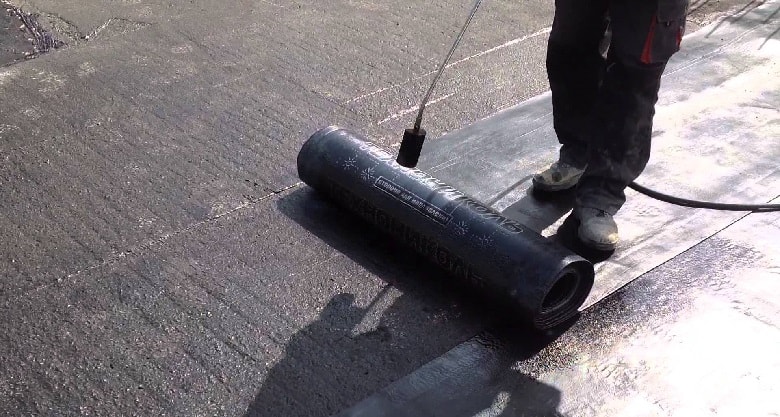
When creating such waterproofing, the selected roll or sheet waterproof building materials are glued to the floor, which is previously well cleaned of dust and treated with a primer.
There are three ways to create a waterproofing coating:
- you can make a simple flooring of materials on the surface, this method is suitable for a dry or cement screed, you can also lay materials under a plywood floor. Waterproofing a wooden floor can also be done in this way.
- Roll materials can be fused to the surface using a torch. This method requires strict adherence to safety standards so that a fire does not happen. It is not recommended to do it yourself; it is better to invite specialists to perform such.
- Roll waterproofing can be glued to the floor using mastic or special glue.
Modern roll-up waterproofing is produced with an adhesive layer, so it is very easy to install it. If you chose materials without such an adhesive layer, you need to buy polymer-bitumen mastic for gluing them. When choosing it, be sure to look in technical characteristics melting point. It is necessary to select a mastic in which this indicator is at least 20 degrees higher than the maximum possible temperature in the room.
Remember that all types of waterproofing lining are very sensitive to tensile and shear loads. Therefore, it is most often used for concrete and brick structures.
Waterproofing with plaster
![]()
This is an old way of protecting the floor from moisture, but it is still used today, as the mixes for plaster have improved. Now you can choose a mixture in which there will be a high concentration of water-repellent additives, this is ideal for waterproofing.This method is good because with the help of a plastic solution you can quickly and reliably fill absolutely all cracks and crevices in the floor, as well as get rid of irregularities. It is convenient to apply it with a spatula or brush.
Waterproofing with plaster is suitable for wood, concrete, stone, tiles, it can even be applied over paint. There is also a filling mixture for waterproofing, which is considered a type of plaster. It is evenly scattered on the floor, absorbing moisture, it hardens and forms a durable layer.
It takes at least 14 days for the waterproofing layer made with plaster to completely solidify. Care must be taken that it does not dry out, otherwise cracks will form on it. It is very important to moisten it with water every 3 hours during the first days after laying the plaster layer; it is convenient to do this with a spray gun. After that, you need to moisten the layer at least twice a week.
Features of waterproofing warm floor
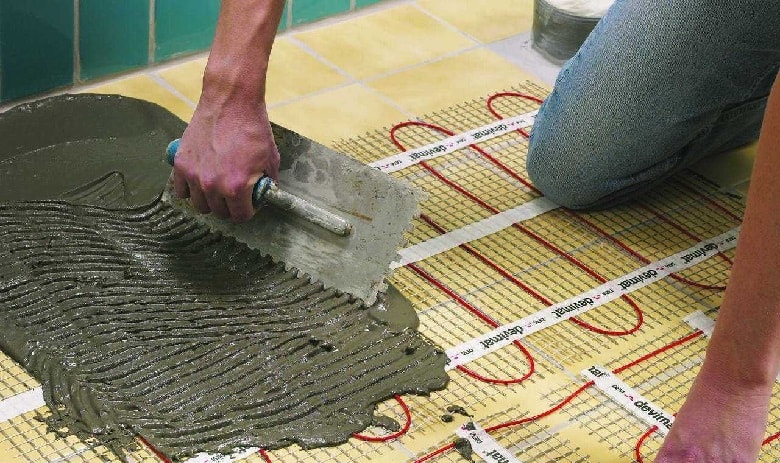
It is very important to observe the technology of creating waterproofing, as it is necessary to ensure reliable protection from water to all elements of the warm floor. Before pouring the screed, you need to treat the base with mastic. You can also use roll materials for this, while it is important to seal all the seams with bitumen mastic, and also overlap them on the walls of at least 30 cm.
There is also an alternative option. You can make a coating waterproofing using bitumen-polymer, cement-polymer or traditional bitumen mastic for this. After complete solidification of such a waterproofing layer, you will need to fill cement-sand screed, on which you can put the finishing floor covering. The result is a reliable and durable waterproofing that perfectly protects all elements of the warm floor from corrosion.
Foundation waterproofing in modern low-rise construction is almost an integral part of the zero-cycle construction process. This is due to the presence of moisture in the soil in the overwhelming majority of territories of our country. By itself, water is not particularly terrible for concrete; on the contrary, in a slightly damp state, concrete continues to gain its strength over the years. However, there are three big BUTs.
First, concrete has such a property as capillarity. This is the rise of water up through the smallest pores inside the material. The simplest example of this phenomenon is the wetting of a piece of sugar, slightly dipped in a glass of tea. In construction, the capillary rise of water leads (unless of course to do waterproofing) to the penetration of moisture first from the outer layers of concrete to the inner ones, and then from the foundation to the walls that stand on it. And damp walls mean an increase in heat loss, the appearance of fungi and mold, damage to interior finishing materials.
Secondly, modern foundation - it's still not concrete. This is reinforced concrete, i.e. it contains reinforcement, which, upon contact with moisture, begins to corrode. At the same time, the iron in the reinforcement turns into iron hydroxide (into rust), increasing in its volume by almost 3 times. This leads to the formation of the strongest internal pressure, which, when a certain limit is reached, also destroys the concrete from the inside.
Thirdly, we do not live in the tropics, and subzero temperatures for our climate in winter are the norm. As everyone knows, when water freezes, it turns into ice, increasing in volume. And if this water is in the thickness of concrete, the ice crystals that form begin to destroy the foundation from the inside.
In addition to the above, there is another danger. It is not uncommon for the groundwater on the site to contain chemical elements (salts, sulfates, acids ...) that have an aggressive effect on concrete. In this case, the so-called "corrosion of concrete" occurs, leading to its gradual destruction.
High-quality waterproofing of the foundation prevents all these negative processes. And how it can be done will be discussed in this article.
By and large, you can protect the foundation from moisture by going in two ways:
1) use when pouring the so-called bridge concrete with a high coefficient of water resistance (various brands of concrete and their characteristics will be discussed in a separate article);
2) cover the foundation with a layer of some kind of waterproofing material.
Ordinary developers most often now follow the second path. What is the reason for this? At first glance, it would seem that it could be easier - I ordered waterproof concrete at the plant, poured it in and that's it, sit and rejoice. But in reality, not everything is so easy, because:
- an increase in the price of a concrete mixture with an increase in the water resistance coefficient can reach 30% or more;
- not every plant (especially a small one) can produce a grade of concrete with the required waterproof coefficient, and attempts to make such concrete on their own can lead to unpredictable consequences;
- well, and most importantly, there are problems with the delivery and placement of such concrete (it has a very low mobility and sets quite quickly, which in most cases limits the possibilities of its use).
The use of a waterproofing coating is available to everyone and with certain skills you can even do it yourself.
Foundation waterproofing materials.
All materials used to protect foundations from moisture can be divided into the following groups:
- coating;
- sprayed;
- roll;
- penetrating;
- plaster;
- screen waterproofing.
Let's dwell on each of them in more detail.
I) Coating waterproofing is a bitumen-based material that is applied to the surface (often in 2-3 layers) with a brush, roller or spatula. Such coatings are commonly referred to as bituminous mastics. They can be made independently or purchased ready-made, poured into buckets.
The recipe for homemade bitumen mastic: buy a briquette of bitumen, split it into small pieces (the finer, the faster it will melt), pour into a metal container and put on fire until it is completely melted. Then remove the bucket from the heat and add waste oil, or better diesel fuel (20-30% of the mastic volume), mix everything thoroughly with a wooden stick. How this is done is shown in the following video:
Ready-made bituminous mastic is sold in buckets. Before use, for a more convenient application, it is usually mixed with the addition of a solvent, for example, solvent, white spirit, etc. This is always reported in the instructions on the label. There are several manufacturers of such mastics with different prices and different characteristics of the finished coating. The main thing when buying them is not to make a mistake and not take material, for example, for roofing or something else.
Before applying the bitumen mastic, it is recommended to clean the concrete surface from dirt and prime it. The primer is made with a special compound, the so-called bituminous primer... It is also sold in stores and has a more liquid consistency than mastic. A coating waterproofing is applied in several layers, each of which is after hardening of the previous one. The total thickness of the coating reaches 5 mm.
This technology is one of the cheapest compared to those that will be described below. But it also has its drawbacks, such as a small durability of the coating (especially prepared on its own), a long duration of work and high labor costs. The process of applying mastic with a brush is shown in the following video:
II) Sprayed waterproofing or the so-called "liquid rubber" is a bitumen-latex emulsion that can be applied to the foundation using a special sprayer. This technology is more advanced than the previous one, because allows you to perform work more efficiently and in a fairly short period of time. Unfortunately, the mechanization of work has a significant impact on its cost.
Characteristics liquid rubber and the process of spraying it is shown in the following video:
III) Roll waterproofing is a bitumen or polymer modified material, previously applied to any base. The simplest example is the well-known roofing material with a paper base. In the production of more modern materials, fiberglass, fiberglass, polyester are used as the basis.
Such materials are more expensive, but also much better quality and durable. There are two ways to work with roll waterproofing - by gluing and fusing. Gluing is carried out on a surface pre-primed with a bituminous primer using various bituminous mastics. Fusion is carried out by heating the material with a gas or gasoline torch and then gluing it. How this is done is shown in the following video:
The use of roll materials significantly increases the durability of the foundation waterproofing compared, for example, with coating materials. They are also quite affordable and affordable. The disadvantages include the complexity of the work. It is quite difficult for an inexperienced person to do everything efficiently. Also, you can't cope with work alone.
The emergence of self-adhesive materials on the markets several years ago made it much easier to work with roll waterproofing. How to protect the foundation with their help is shown in the following video:
IV) Penetrating waterproofing - This is a coating of concrete with special compounds that penetrate through the pores into its thickness by 10-20 cm and crystallize inside, thereby blocking the passages for moisture. In addition, the frost resistance of concrete and its protection against chemically aggressive groundwater increases.
These compositions (Penetron, Hydrotex, Aquatron, etc.) are quite expensive and have not been widely used for complete waterproofing of the foundation in a circle. They are more often used to eliminate leaks in already built and operated basements from the inside, when it is no longer possible to repair the waterproofing from the outside by other methods.
For more information on the properties of penetrating materials and their correct application, see the following video:
V) Plaster waterproofing by and large it is a type of coating insulation, only here not bituminous materials are used, but special dry mixtures with the addition of waterproof components. The prepared plasters are applied with a trowel, trowel or brush. For greater strength and to prevent cracking, a plaster mesh can be used.
The advantage of this technology is the simplicity and speed of application of materials. The downside is the low durability of the waterproofing layer and the lower, in comparison with the above-described materials, water resistance. The use of waterproofing plasters is more advisable for leveling the surfaces of foundations or, for example, for sealing joints in foundations from FBS blocks, before their subsequent coating with bitumen or roll waterproofing.
VI) Screen waterproofing - this is sometimes called the protection of foundations from moisture with the help of special swelling bentonite mats. This technology, which is essentially a replacement for the traditional clay castle, appeared relatively recently. Mats are attached to the foundation with dowels with overlap on each other. More information about what this material is and about its properties is described in the following video:
How to choose a foundation waterproofing?
As you can see, currently there is a huge number of all kinds of waterproofing materials for the protection of foundations. How not to get confused in this variety and choose exactly what is suitable for your specific conditions?
First, let's see what you need to pay attention to when choosing waterproofing:
- the presence or absence of a basement;
- ground water level;
- type of foundation and method of its construction
The different combination of these three factors determines which waterproofing should be preferred in this case. Let's consider the most common options:
1) Columnar foundations.
 can only be protected with roll-up waterproofing. To do this, cylinders of the required diameter are pre-rolled out of it, fixed with tape, lowered into drilled wells, reinforcing cages are installed and concrete is poured.
can only be protected with roll-up waterproofing. To do this, cylinders of the required diameter are pre-rolled out of it, fixed with tape, lowered into drilled wells, reinforcing cages are installed and concrete is poured.
The cheapest option is to use ordinary roofing material. If it is sprinkled, it is better to roll the smooth side outward so that in winter when freezing, the soil will stick to it less. It is advisable to make sure that the thickness of the waterproofing around the entire circumference is at least two layers.
When used for columnar foundation asbestos or metal pipes, they can be pre-coated with any coated bitumen waterproofing at least 2 layers.
If you are going to erect on pillars, before pouring it, for greater reliability, the tops of the pillars must also be covered with a coating waterproofing (even better not as in the picture below, but directly from the ground). This will prevent a possible capillary rise of water from the ground into the grillage.
2) Shallow strip foundations (MZLF).
 in essence, they should always be above the water table. Therefore, for its waterproofing, ordinary roofing material and bitumen mastic are quite enough to prevent capillary suction of moisture from the soil.
in essence, they should always be above the water table. Therefore, for its waterproofing, ordinary roofing material and bitumen mastic are quite enough to prevent capillary suction of moisture from the soil.
The figure shows one of the working options. Before the installation of the formwork, a double-folded roofing material with a small release is spread on the sand cushion. Then, after pouring and setting the concrete, the side surfaces of the tape are covered with a coating waterproofing. Above the level of the blind area, regardless of what kind of base you have (concrete or brick as in the figure), a shut-off waterproofing is done by gluing 2 layers of roofing material to the bituminous mastic.
3) Recessed strip foundations (house without a basement).
Waterproofing of a buried strip foundation, regardless of whether it is monolithic or from FBS blocks, when a basement is not provided in the house, can be done according to the scheme shown above for MZLF, i.e. the bottom is rolled material, and the side surfaces are covered with coating insulation.
The only exception is the option when the foundation is poured not into the formwork, but directly into the dug trench (as you understand, the coating will not work). In this case, before installing the reinforcement cage and pouring concrete, the walls and bottom of the trenches are covered with roll waterproofing with gluing or fusion of joints. The work is certainly not very convenient (especially in a narrow trench), but there is nowhere to go. This was discussed in the article.
Also, do not forget about the cut-off waterproofing layer above the blind area.
4) Recessed strip foundations are the walls of the basement.
The use of coating and sprayed materials for waterproofing the walls of the basement outside is permissible only in dry sandy soils, when the groundwater is far away, and the top water quickly leaves through the sand. In all other cases, especially with a possible seasonal rise in groundwater, it is necessary to make roll waterproofing in 2 layers using modern materials based on fiberglass or polyester.
If the foundation is composed of FBS blocks, it is advisable to cover the seams between the individual blocks with a plaster waterproofing mixture before waterproofing it, at the same time leveling the surface.
5) Slab foundations.
Foundation slabs (basement floors) are traditionally protected from moisture from below by gluing two layers of roll-up waterproofing onto the previously poured concrete preparation... The second layer is spread perpendicular to the first. This was discussed in more detail in the article.
In order not to damage the waterproofing layer during subsequent work, try to walk on it as little as possible, and immediately after installation, close it with extruded polystyrene foam.
At the end of the article, let's pay attention to two more points. First, when the groundwater level rises above the basement floor level, drainage must be done (a system of drainage pipes laid along the perimeter of the house and wells for inspection and pumping out water). This is a big topic that will be covered in a separate article.
Second, layer vertical waterproofing foundation requires protection from damage that can occur during backfilling and compaction of the soil, as well as during frosty heaving of the soil in winter, when it adheres to the waterproofing and drags it up. This protection can be achieved in two ways:
- the foundation is covered with a layer of extruded polystyrene foam;
- install special protective membranes, which are now on sale.
Most builders prefer the first method because it allows you to "kill two birds with one stone" at once. EPPS protects waterproofing and insulates the foundation. Warming of foundations is described in more detail.
The foundation and basement of the house are the most vulnerable areas on which the hydraulic pressure of groundwater and atmospheric precipitation is exerted. The additional load can be reduced by installing a strong moisture-resistant insulation layer. Excess liquid collects in the walls, leading to the appearance of fungus and smoldering finishing materials and load-bearing structures... How to make basement waterproofing so that such problems do not arise?
It is very important to take into account the groundwater level at the place of construction of the house.

Groundwater location
The waterproofing barrier is equipped in the following cases:
- Groundwater is located above 1 meter from the level of the foundation to be laid. This is high, therefore it is necessary to ensure a high-quality external and internal watertightness of the basement.
Advice!
In cases of a high location of groundwater, experts recommend additionally equipping the drainage system. This will prevent the building from hydrostatic pressure, which can cause the foundation of the house to shift and deform the walls.
- Groundwater is below 1 meter from the base. In this case, simple wall waterproofing is suitable.
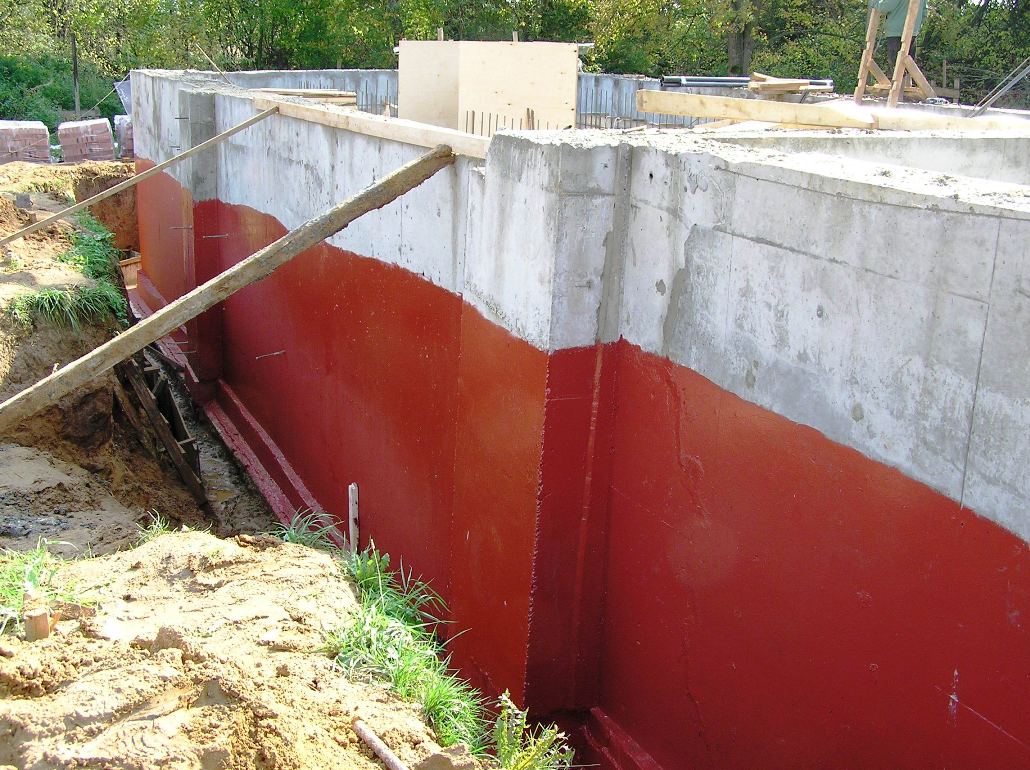
External waterproofing of the basement at the stage of foundation construction
External waterproofing is not possible in already built and tiled houses. Therefore, work must be done from the inside. In this case, the effectiveness of waterproofing will decrease significantly. To increase the water-repellent properties, it is recommended to carry out a complex waterproofing of the building against the absorption of excess liquid by treating the walls and floor of the basement.

Types of basement waterproofing
The internal waterproofing agent is selected according to the selected application method. There are 3 types of waterproofing: anti-pressure, non-pressure and anti-capillary.

Types of basement waterproofing
- Anti-pressure waterproofing is performed when the groundwater level is above the level of the basement or basement floor. The foundation is waterproofed outside the building. The materials used restrain the positive water pressure. Additionally, a drainage system of the area is being performed to drain the liquid into the drain. Means for performing anti-pressure, or slurry, waterproofing necessarily contain polymers. A bitumen-polymer composition is applied to a surface pre-treated with a silicate primer. Slurry waterproofing is a multi-layer surface consisting of different solutions and mastics.
Important!
Performing anti-pressure waterproofing from the inside is a useless exercise. Since water exerts negative pressure on the walls of the house, and is not held back by narrowly targeted insulating materials.
- Non-pressure waterproofing is performed when urgent protection of the basement from already accumulated moisture is needed. If the groundwater is located low, it is quite possible to cope only with non-pressure waterproofing of the walls and base. In this case, bituminous mastics are selected, which are applied with a spatula or roller to the surface of the walls.
- Anti-capillary waterproofing is used to prevent moisture from entering through the capillaries located in concrete wallsoh. Previously, only bituminous barrier mastics and roofing felt protective layer on the foundation. Currently, the most popular are penetrating waterproofing materials. Condensation does not collect on the walls of the basement if they are pre-treated with barrier mixture injections. They penetrate the voids and fill them, blocking the flow of water.
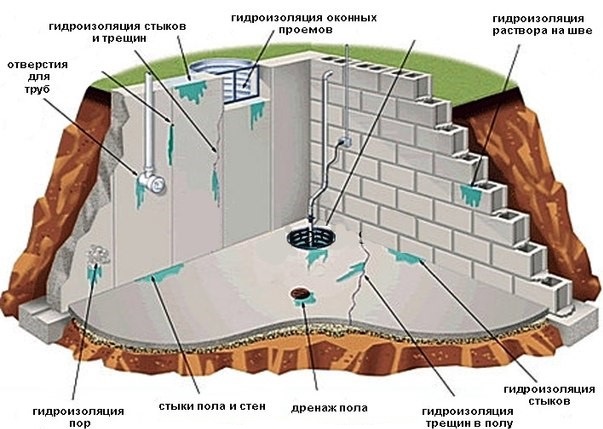
Sources of moisture in the basement
The highest quality is the outer protection of the basement from groundwater. Quite often, external waterproofing is missing or damaged. It is sometimes impossible to repair it. Therefore, there is an urgent need for the arrangement of internal insulation. In such cases, the basement is waterproofed from the inside with your own hands without the use of special equipment and earthworks.

Basement waterproofing is a guarantee of warmth and comfort in the house
Penetrating compounds and membrane waterproofing sheets are currently used. Membrane slabs are laid on the walls using a gas burner, forming a dense, water-repellent layer.
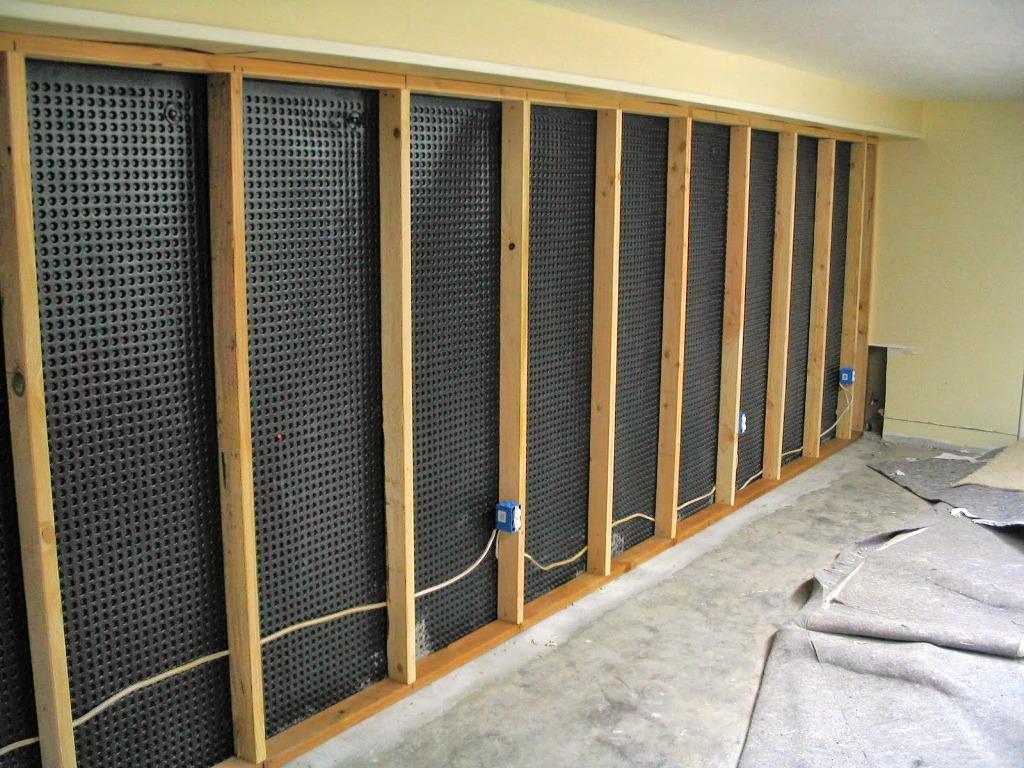
Basement membrane waterproofing
Penetrating coatings form insoluble, water-repellent barrier compounds by chemically reacting with concrete. Thus, the composition penetrates into the capillaries and fills the pores, chips and microcracks in the concrete.
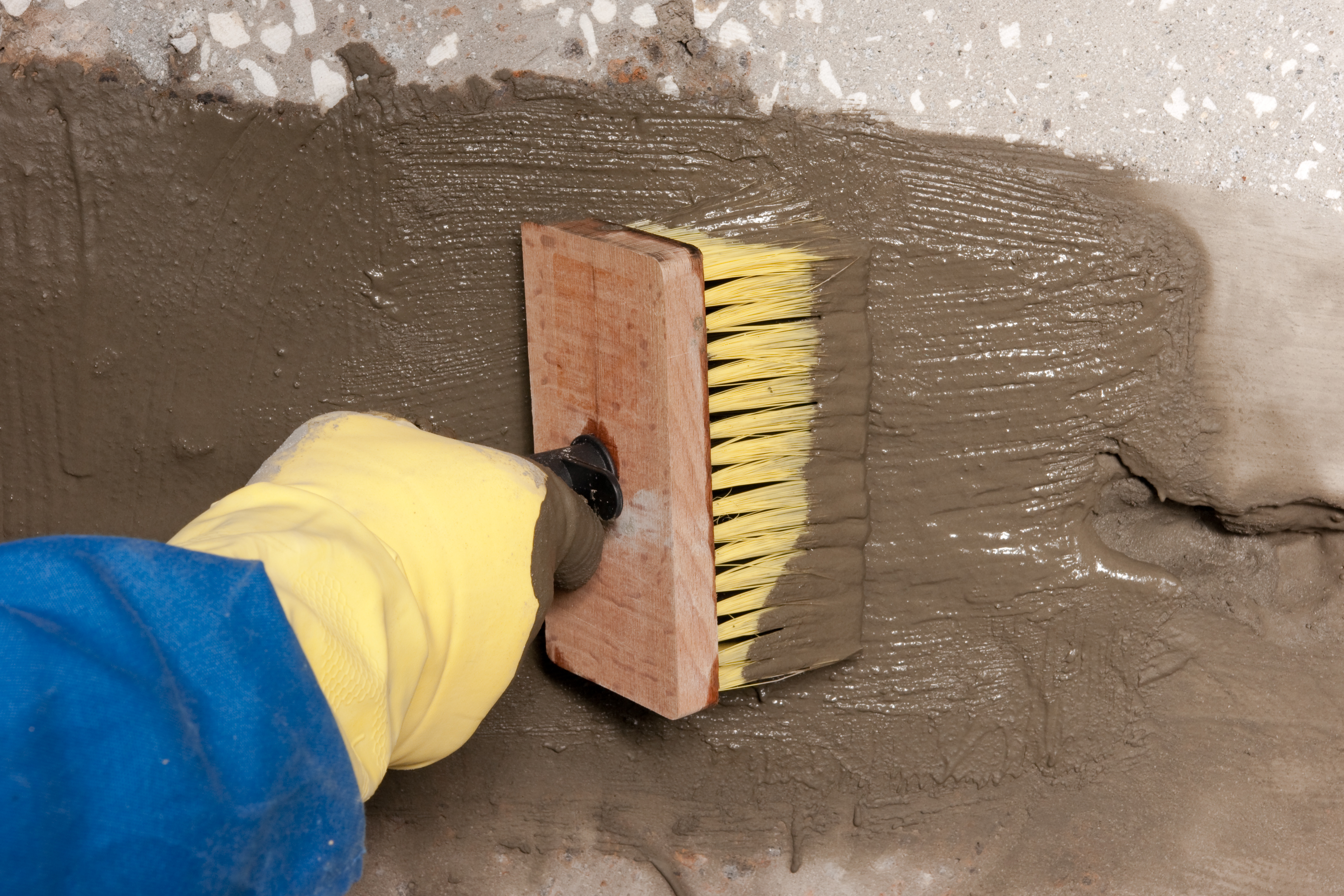
Anti-capillary basement waterproofing with bitumen mastics
How to properly waterproof a basement with bituminous mixtures? Internal water repellents for the basement are polymeric mastics. The high demand for such water-repellent products is due to the low price and good properties.
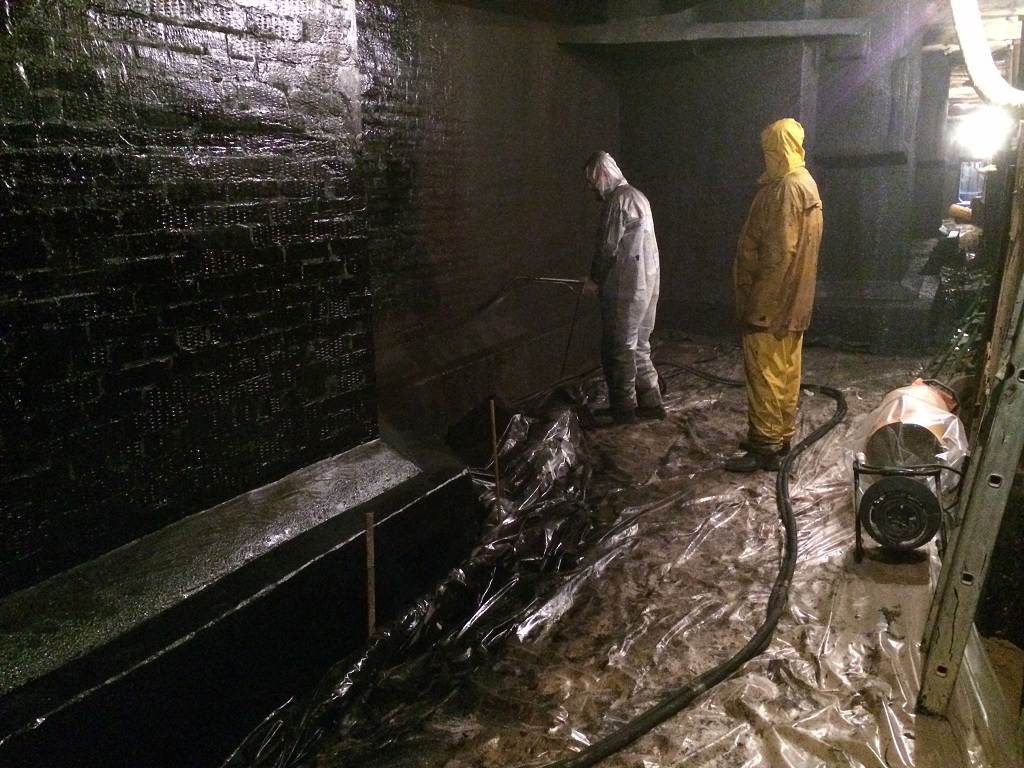
Basement anti-capillary waterproofing with bitumen mastic
Work on the application of bitumen mastic is carried out in the following sequence:
- walls are cleaned, if necessary, all debris and residues are removed old finish;
- with fine-grained cement mortar, trim the surfaces of the walls, wipe cracks and potholes;
- prime the surface with a quick-drying primer;
- Apply the waterproofing layer of the mastic with a spatula.

Waterproofing with bitumen-based mastic
Adhesive insulation
The glued waterproofing forms a monolithic sheet, which consists of several layers of rolled materials.
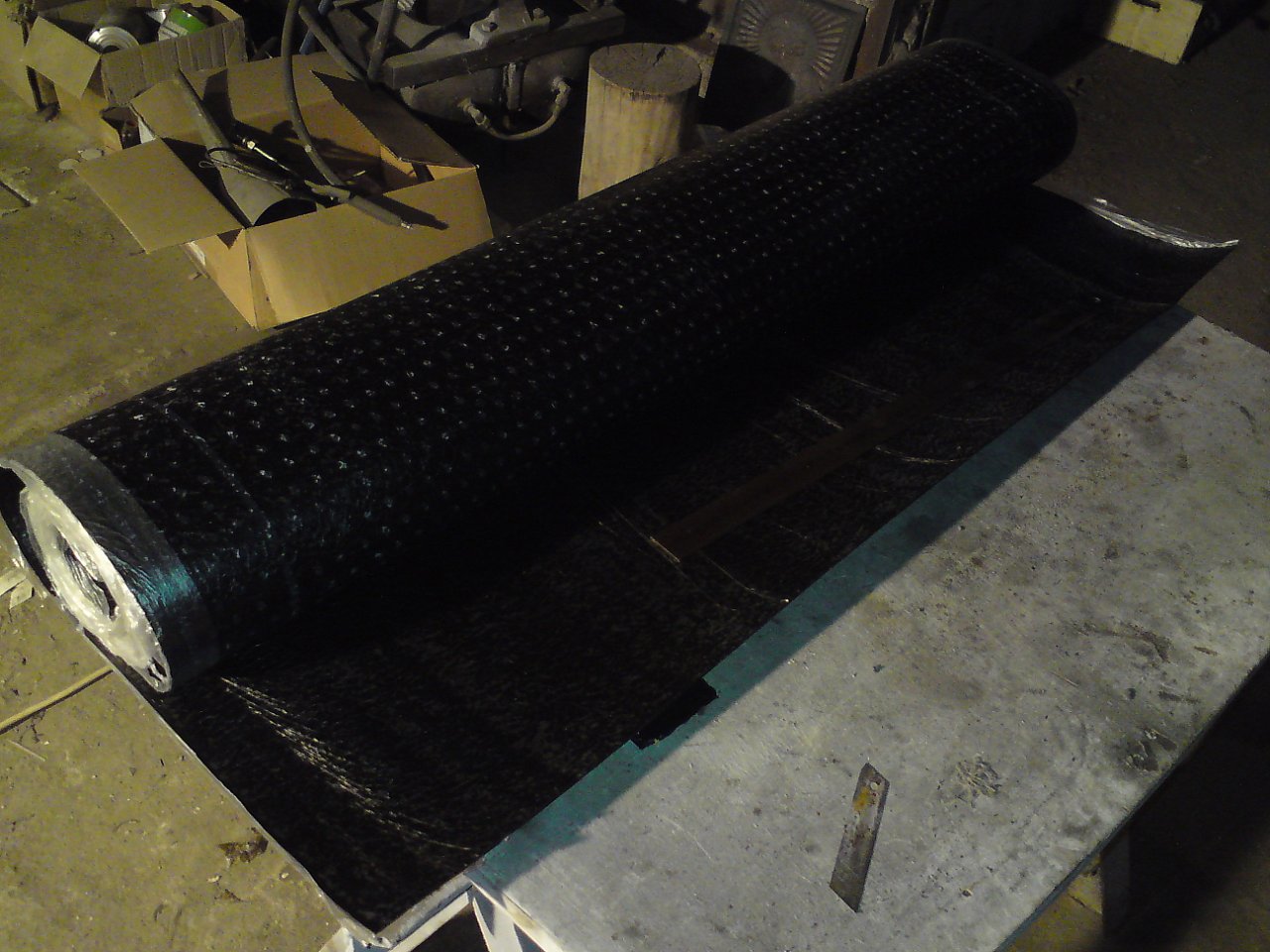
Roll waterproofing
Roll coatings are glued by heating the base with gas burners or on bitumen glue. The scheme of work is as follows:
- mastic is applied to the basement wall;
- then a roll insulator is glued to the mastic layer, rolling with a roller;
- the overlap places are treated with mastic and the next layer of the roll cloth is glued;
- rolled waterproofing sheets are rolled with a roller. They can be glued both vertically and horizontally. Excess material at the edges is trimmed with a sharp knife.

Roll basement waterproofing at the initial stage of construction
Wall plastering is performed on any uneven wall surfaces with potholes and cracks.

Plaster waterproofing
The scheme of the work performed is as follows:
- Clean the surface to be treated from debris and old cladding with a wire brush or spatula.
- Apply a layer of primer for best adhesion of materials.
- Install level beacons.
- Throw ready-made waterproofing plaster into the spaces between the lighthouses, having previously prepared it in accordance with the instructions on the package.
- Level the surface with the rules, focusing on the beacons.
- Remove the beacons after the plaster has set and fill the resulting joints with mortar, level the surface with a spatula.
- Finish dry plaster with a finishing layer of mortar.
Waterproofing plasters contain modifiers, plasticizers, binding adhesion additives and components. Can be used for outdoor and indoor use.
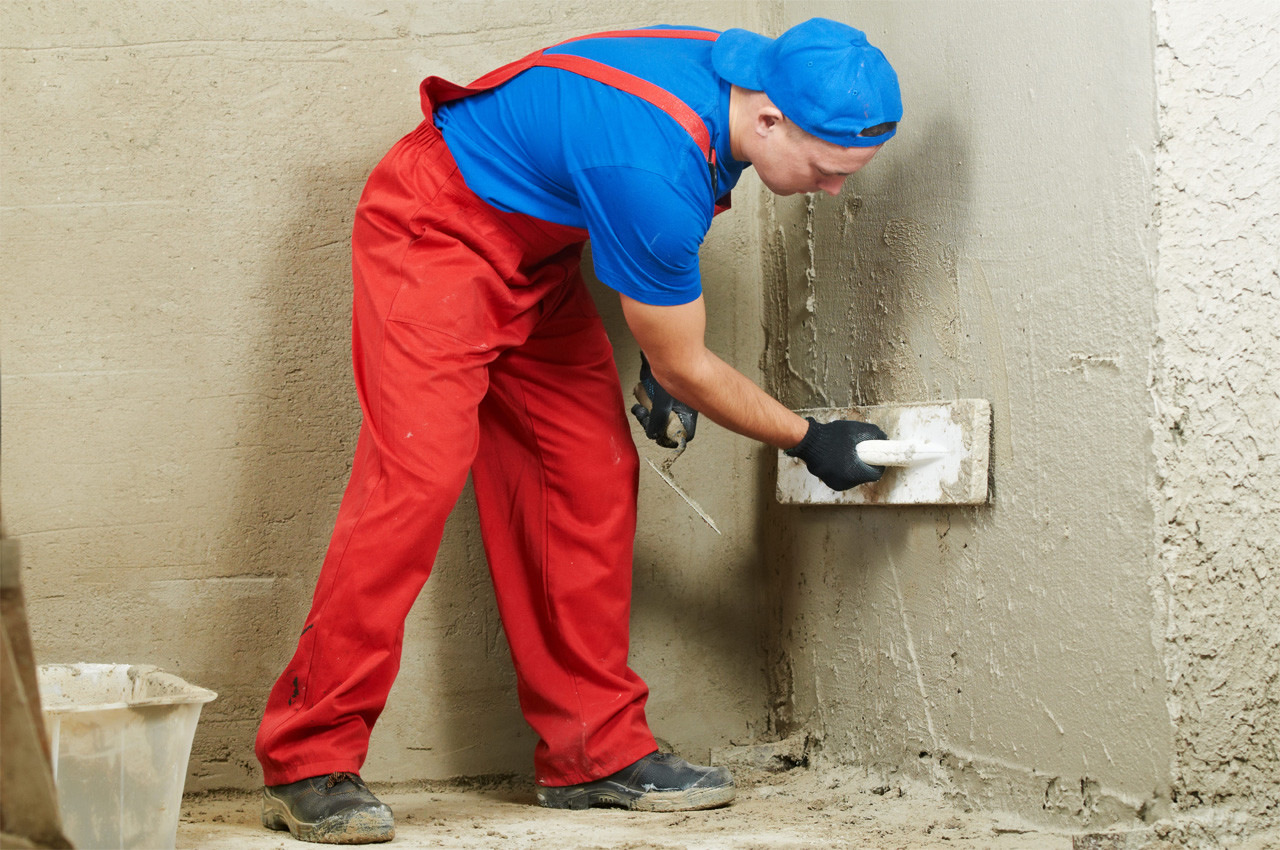
Waterproofing with plaster
Basement penetrating waterproofing
Penetrating water-repellent compounds can be divided into types:
- mixtures applied from inside and outside the building to concrete surfaces;
- compounds for sealing joints, chips, seams, cracked surfaces;
- fast-hardening compounds that stop leaks in a few minutes;
- compositions for adding to concrete solution.

Basement waterproofing penetrating action
The difficulty of using penetrating mixtures is that special techniques or laborious manual cleaning are required to clean concrete walls.
Important!
The composition penetrates into the concrete capillaries only if they are open. If the capillaries are clogged, the penetrating moisture-repellent compound will not penetrate the concrete, and the work will be done in vain.
Basement waterproofing works with the help of penetrating compounds are carried out only on freshly poured or damp concrete. The mixture is applied with a spatula or brush in one to two millimeters. After the first layer has dried, a second one is applied.
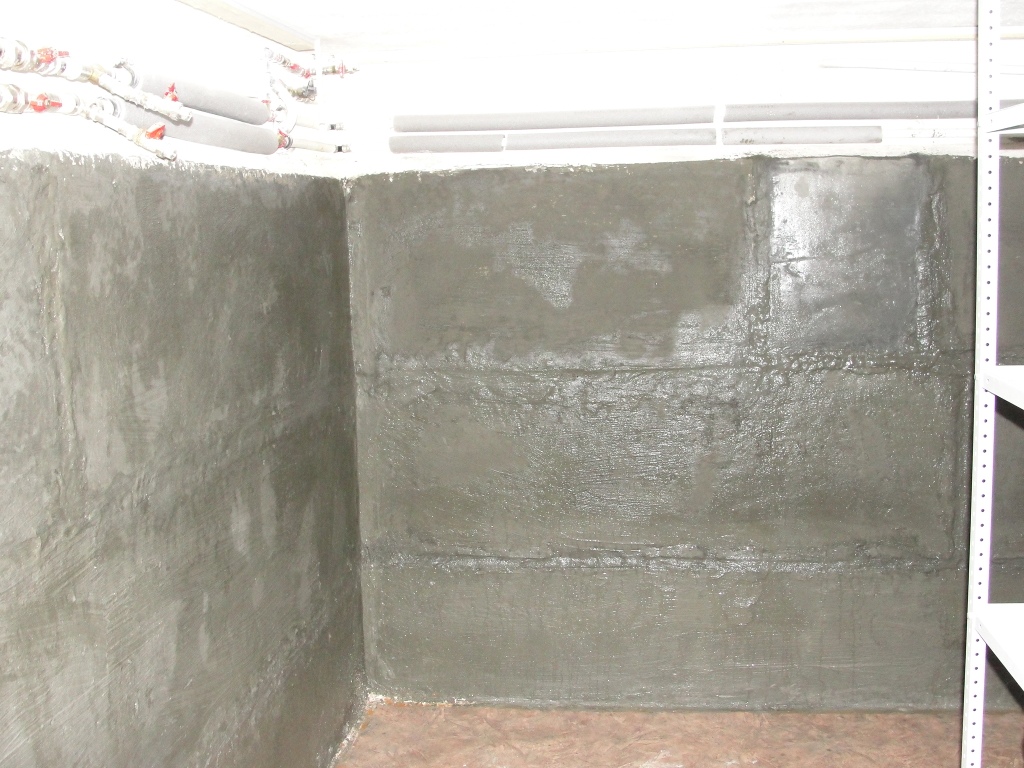
Penetrating basement wall waterproofing
Liquid rubber waterproofing scheme
Liquid rubber - the latest bitumen-polymer water-repellent material... It can be used to further increase waterproofing properties walls and floor in the basement. One-component formulations can be easily applied independently with a roller or brush on a flat surface.
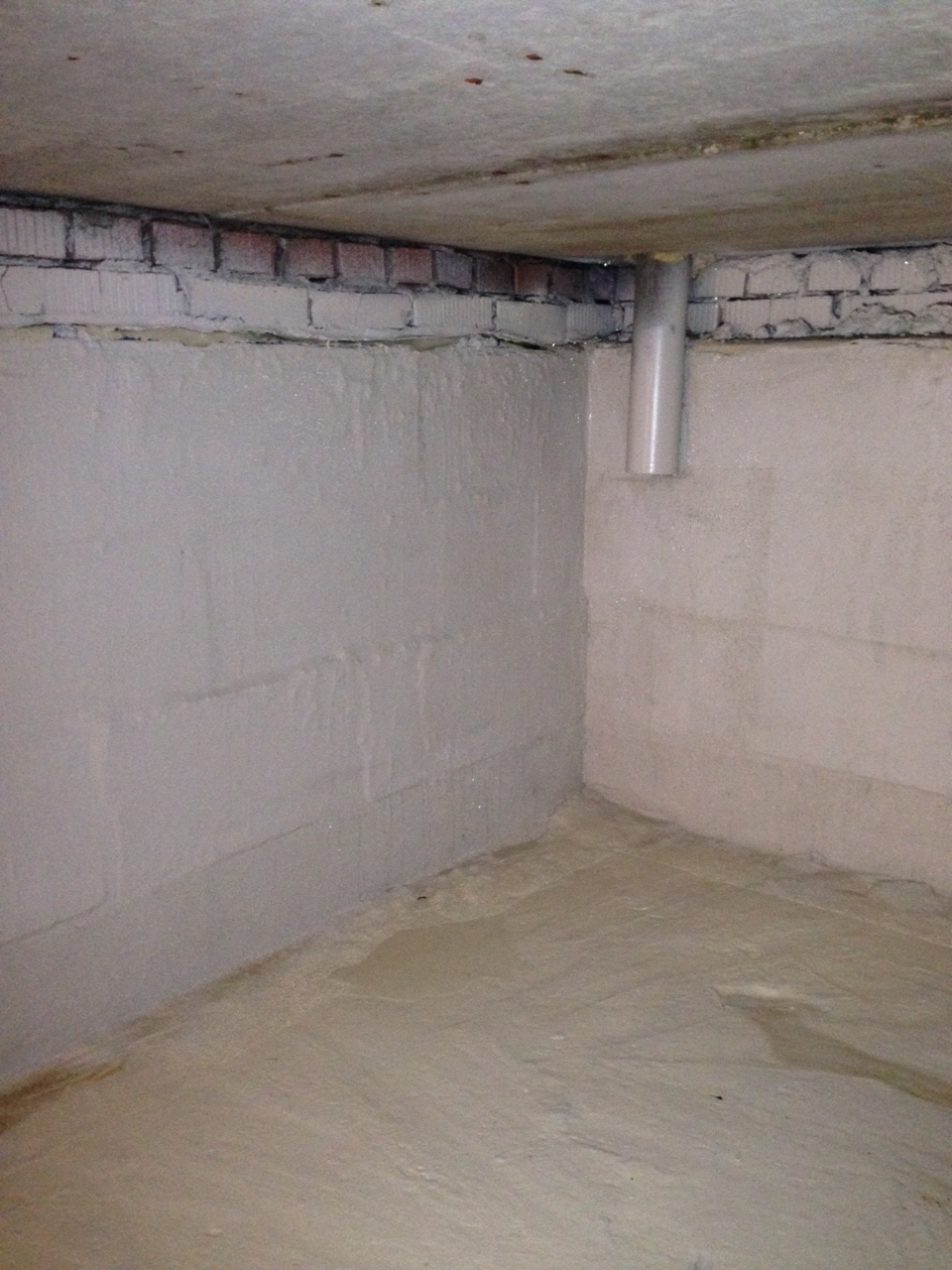
Basement waterproofing liquid rubber
The order of work:
- Before applying the mixture, it is necessary to thoroughly clean the surfaces to be treated and fill in the potholes and irregularities.
- Treat walls and floors with a primer.
- Thoroughly mix the liquid rubber composition using a drill and a mixing nozzle.
- Apply the mixture with a brush, roller or spatula.
- After complete hardening, the coating is ready for use.
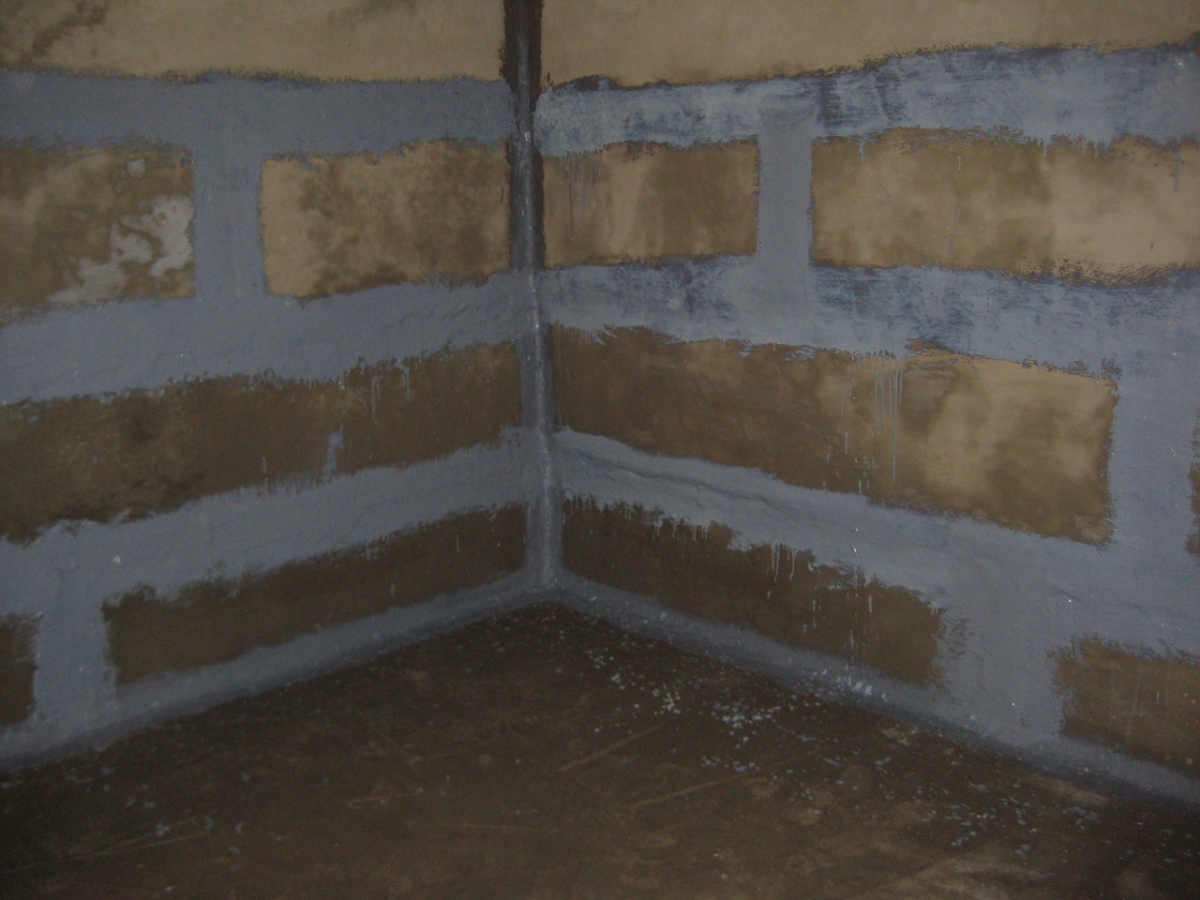
Waterproofing joints with liquid rubber
Despite the assurances of the liquid rubber manufacturers that the composition penetrates 15 millimeters deep into the concrete, under the strong pressure of high groundwater, the coating begins to peel off and ultimately can last no more than 5 years. An additional floor screed will extend the life of the rubber water-repellent compound.

Basement waterproofing with liquid rubber
There are several methods for waterproofing a floor:
- painting;
- pasting;
- impregnating;
- cast.
The painting method is used for pouring concrete floor covering. This is the simplest type of moisture protection. Paint waterproofing is carried out with barrier polymer-bitumen compounds. This polymer is short-lived and loses its elastic properties over time, forming cracks. In our time, preference is given to bitumen-rubber mastics, which do not lose their elasticity for a long time.
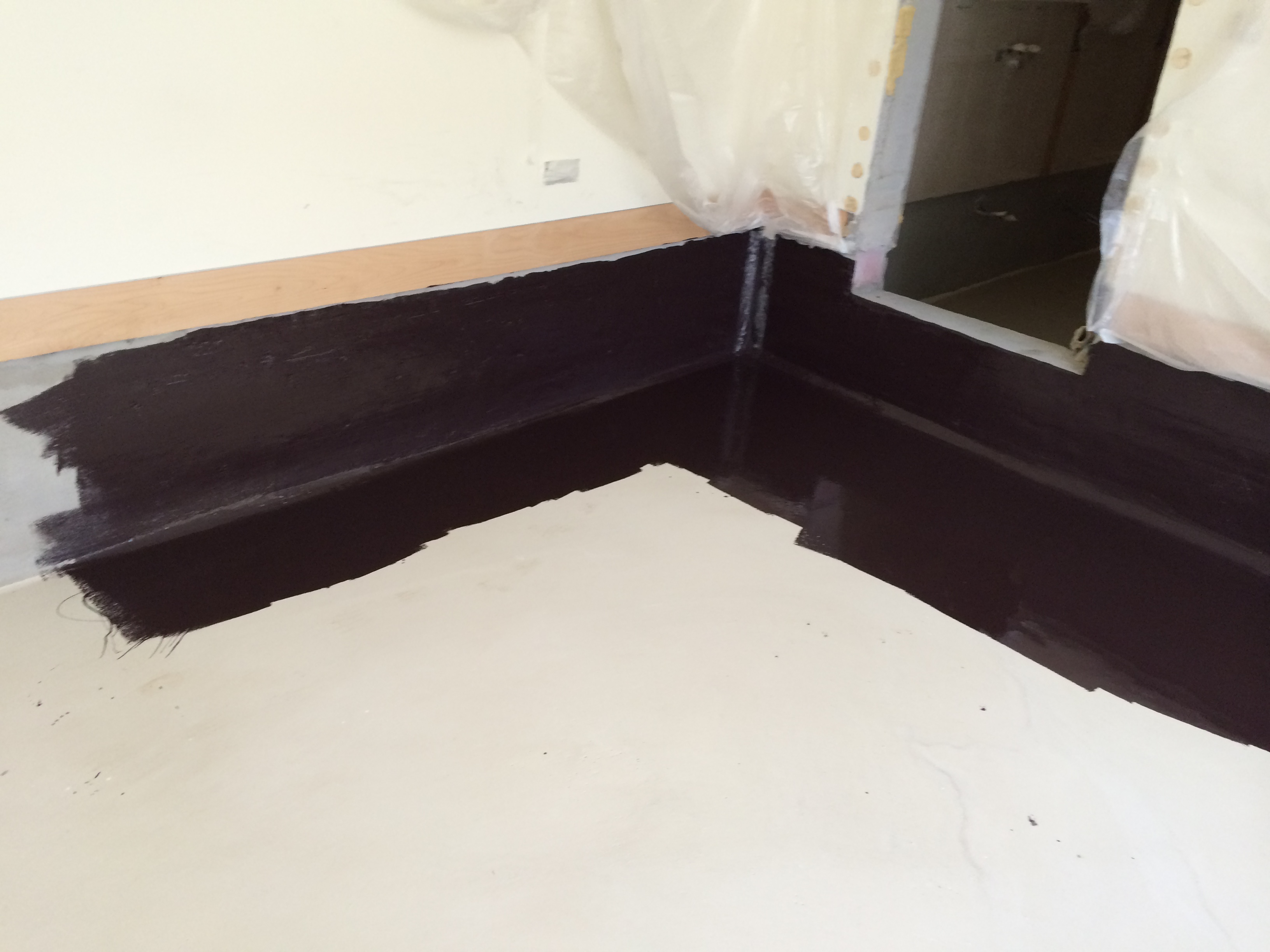
Floor paint waterproofing
The gluing method of waterproofing is applied during the flooring. At the stage of the final concrete screed, layers of sheet or barrier roll materials are laid. Each layer is glued with a bitumen-polymer primer, depending on the selected material. Thus, a dense, reliable and moisture-resistant polymer coating is obtained. It is enough to lay three layers of coating.
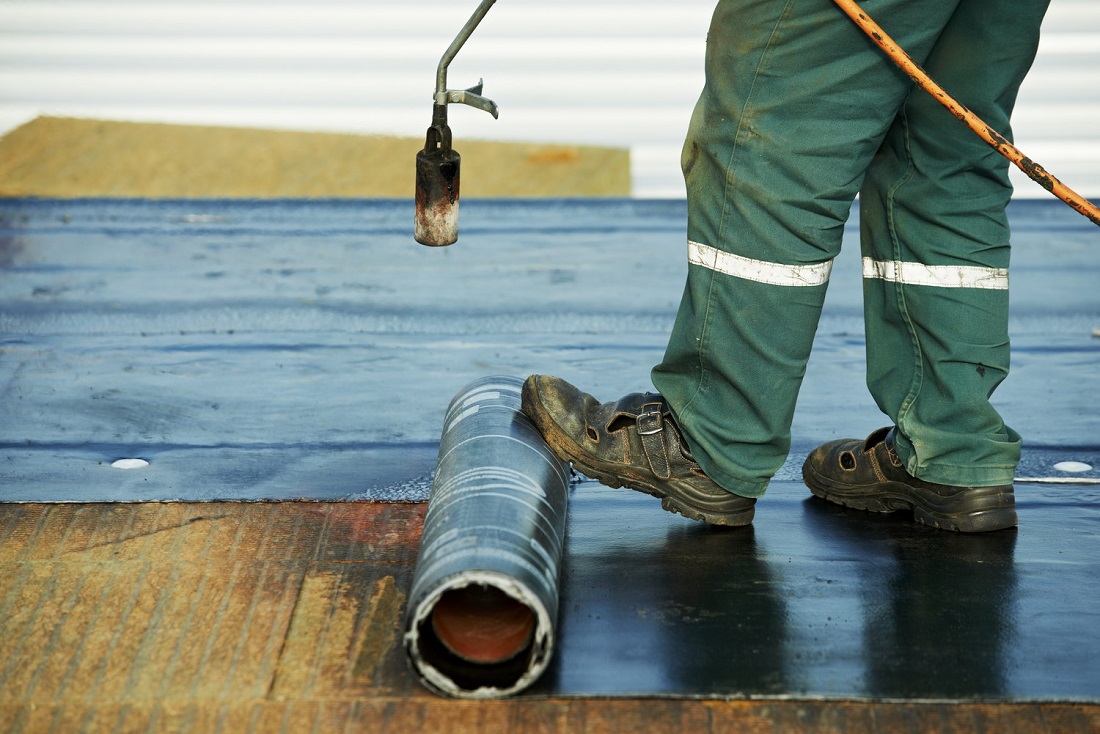
The glued method of waterproofing the floor
The impregnating method of waterproofing is used before the floor is tiled with wood, linoleum or tiles. The composition of impregnating mixtures necessarily includes polymer substances, such as varnish.

Impregnation method for waterproofing the floor
The cast method of waterproofing the basement floor is by far the most reliable. A fence is installed between the walls and the basement floor. A polymer solution is poured into the resulting space, after drying, a dense continuous cast bitumen-polymer moisture-repellent coating is formed.

Cast waterproofing
Waterproofing is subdivided into types in accordance with the temperature operating conditions:
- cold;
- hot;
- asphalt-polymer.
Important!
Any process of arranging a waterproofing layer must be carried out continuously. Places of joints, overlaps and abutments of the coating roll cloth must be carefully processed additional layer bituminous or barrier polymer mastic.
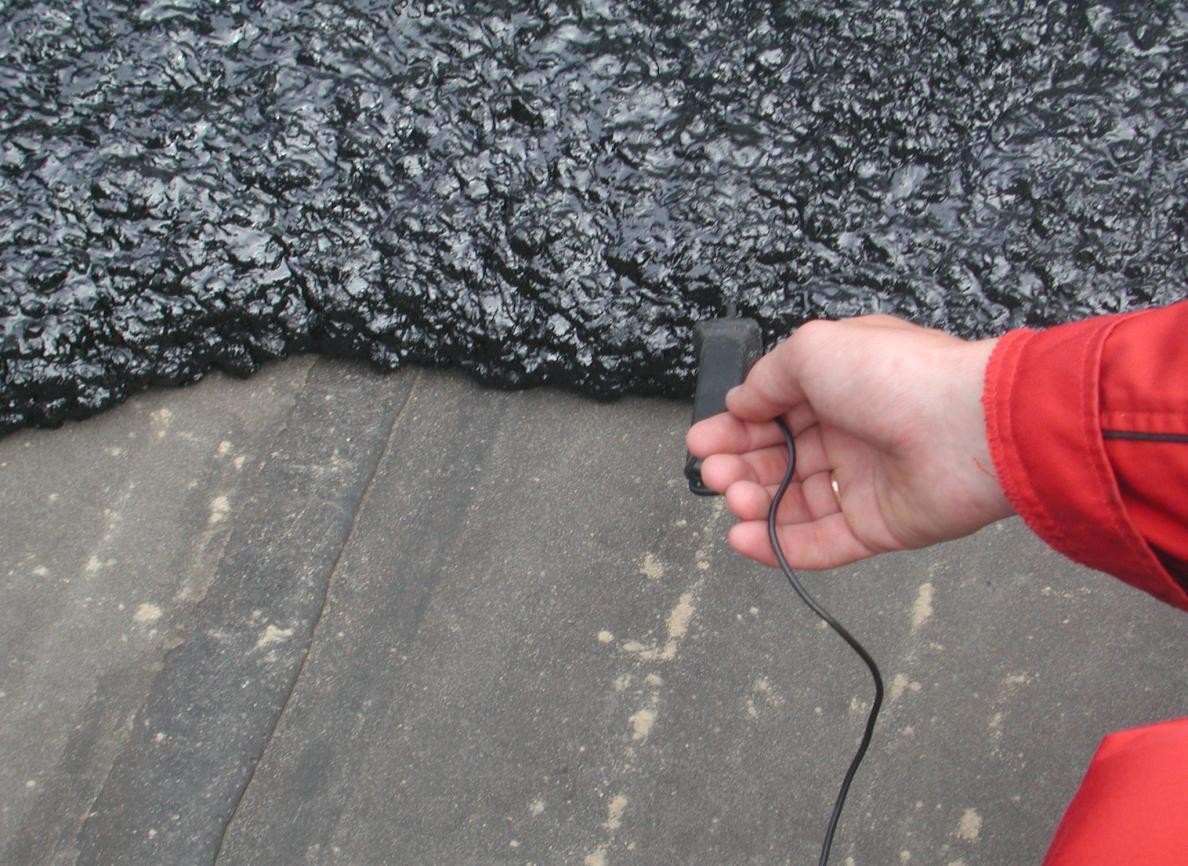
Asphalt-polymer waterproofing
Basement waterproofing will be more effective if the basement ventilation system is installed. It is possible to enhance the work of the equipped ventilation with the help of a forced supply duct.
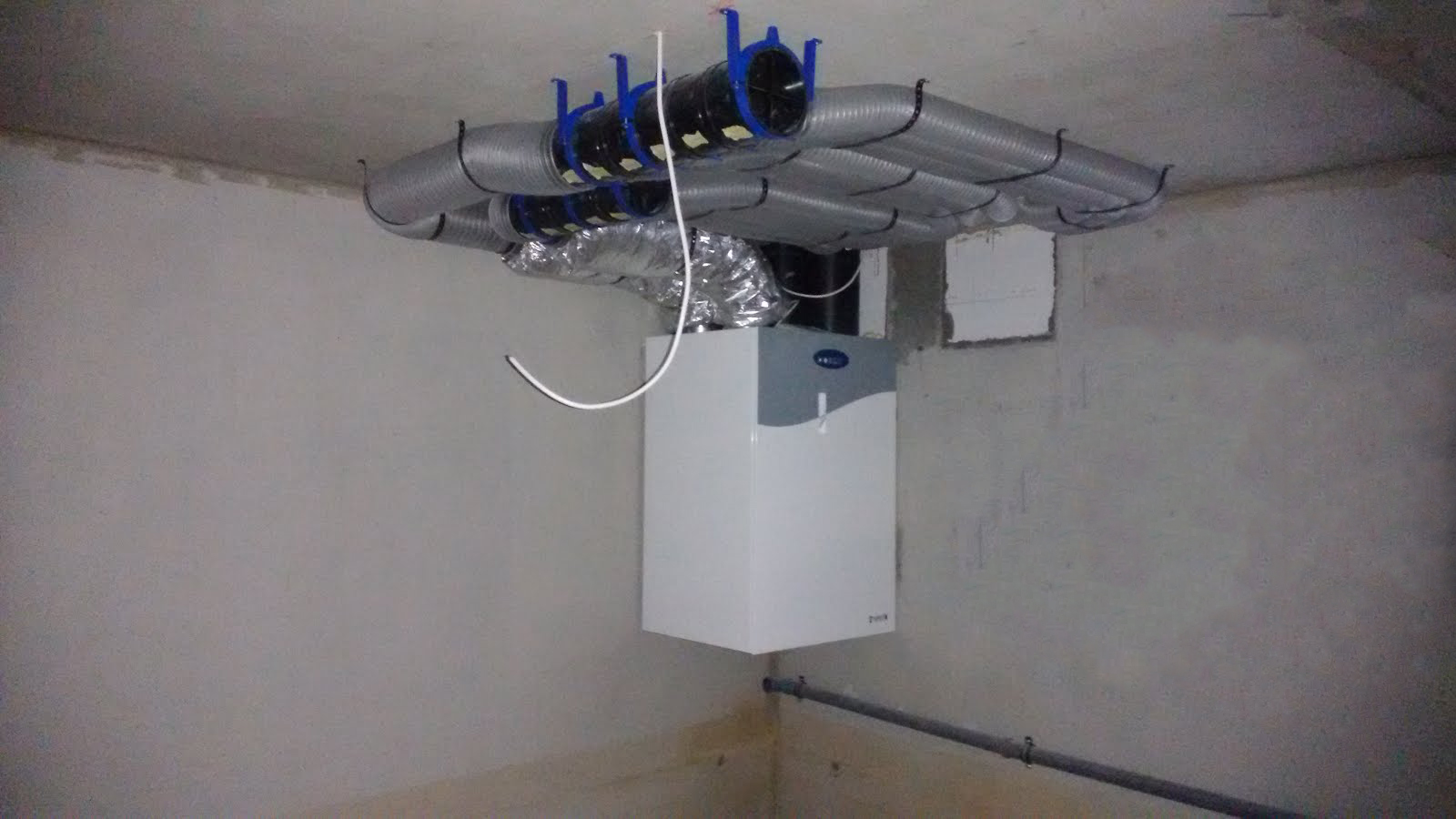
Automatic ventilation of the basement
A properly equipped waterproofing system will extend the life of not only the basement, but also the entire house, prevent dampness, the occurrence of fungi, mold and decay of materials.



